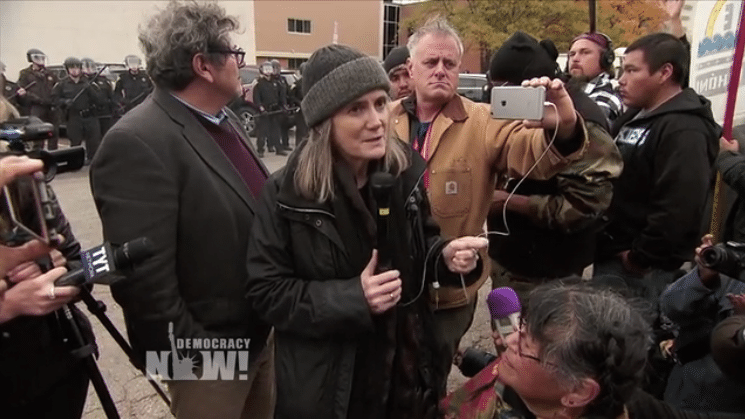On September 8, award-winning journalist Amy Goodman of Democracy Now! received news of her arrest for reporting at the scene of the heated Dakota Access pipeline protests five days earlier during the Labor Day weekend.
On October 17, she showed up at North Dakota’s Morton County courthouse to face the charge brought against her. It was quickly dropped by the judge for lack of probable cause.
In reaction to this news, Goodman commented, “This is a vindication of freedom of the press, of the First Amendment, of the public’s right to know. I see the media really as the ‘Underground Railroad’ of information. And that information must continue on all things that are happening. That’s our job.”
The Job of Journalists
Even as Goodman arrived in North Dakota to face her charge— which was swapped at the last minute Friday from “criminal trespass” to “riot” — she continued performing the job which originally brought her to the state: reporting on the issues surrounding the protests against the construction of the $3.8 billion Dakota Access pipeline.
Her report from October 17 features interviews with Native American protesters sharing experiences of law enforcement strip-searches and detentions without bail or bond when charged with minor offenses. Over the Labor Day weekend, Goodman was the lone media presence covering Dakota Access security officers releasing dogs on and pepper spraying mostly Native American protesters as bulldozers destroyed a site recently identified as sacred.
Deia Schlosberg
Award-winning documentary filmmaker Deia Schlosberg, who was arrested October 13 while filming activists shutting down tar sands pipelines and who herself faces three felony conspiracy charges, showed a similar desire to focus on the responsibility of the press to highlight what is happening around fossil fuel infrastructure protest actions in North Dakota.
In an October 15 video posted to Facebook, Schlosberg said:
“I just wanted to express my extreme gratitude to the unbelievable outpouring of support I’ve received in the past 24 hours … I feel amazingly supported and that gives me hope that this is going to work out and we can move the focus back to where I think it should be, the original story I was trying to cover, the activists and the stopping of using tar sands and extraction of fossil fuels.”
Meanwhile, former NSA contractor Edward Snowden has pointed out that while he faces 30 years in prison for espionage, Schlosberg’s charges have the potential for 45 years of jail time.
This reporter is being prosecuted for covering the North Dakota oil protests. For reference, I face a mere 30 years. https://t.co/GzMbwCVV40
— Edward Snowden (@Snowden) October 14, 2016
Law Enforcement Deciding Who Is a Journalist
Gasland documentary filmmaker Josh Fox immediately came to the defense of Schlosberg, who produced his latest film, which explores climate change’s impacts:
“These charges are a threat to our freedom of expression on the most basic level and especially to documentary filmmaking. If we cannot film events as they’re happening, especially protest events or events that the establishment and the police might consider crime, we will never work or live in the same way again.”
Pembina County, North Dakota attorney Ryan Bialas, who is pursuing charges against Schlosberg, would likely disagree with Fox. He told the Huffington Post that he considers the event she was reporting on “criminal action,” but that his office does “not target activists, journalists or media.”
However, North Dakota has made a trend of arresting journalists covering the oil and gas protests in the state. Even if the charges don’t stand, these aggressive actions are seen by many as attempts to intimidate those shining perhaps an unwelcome light on a state that doesn’t often make the news — and an industry with a history of attempting to manipulate its coverage.
According to The Nation, North Dakota state attorney Ladd Erickson, who charged Goodman with rioting, “switched up the crimes she had allegedly committed just days before she was set to appear in court, because, he admitted in an email to Goodman’s lawyer, there were ‘legal issues with proving the notice of trespassing requirements in the statute.’”
The Nation went on to report:
“When asked to explain the grounds for arresting a working journalist, Erickson told the Grand Forks Herald that he did not, in fact, consider Goodman a journalist. ‘She’s a protester, basically,’ Erickson told the newspaper. ‘Everything she reported on was from the position of justifying the protest actions.’ And in The Bismarck Tribune he later added, ‘I think she put together a piece to influence the world on her agenda, basically. That’s fine, but it doesn’t immunize her from the laws of her state.’”
Rolling Stone writer Matt Taibbi, whose work Erickson apparently admires and considers journalistic, called out this disturbing trend of law enforcement deciding who is and is not a journalist — a profession explicitly protected by the First Amendment:
“But a prosecutor who arrests a reporter because he doesn’t think she’s ‘balanced’ enough is basically telling future reporters what needs to be in their stories to avoid arrest. This is totally improper and un-American.”
“Ascertaining the truth about a vital public issue”
Journalism is not a particularly well-liked profession among the public and is sometimes accused of having a liberal bias.
But as The Nation’s environmental correspondent Mark Hertsgaard recently wrote, “Ascertaining the truth about a vital public issue and sharing it with the American people is not liberalism. It is journalism.”
Digital age transformations are increasingly opening up the opportunity for citizen and nontraditional journalists to report on pressing events that might not otherwise receive attention.
For example, Divergent actress Shailene Woodley was arrested at the scene of another Dakota Access pipeline protest while livestreaming the event to thousands of people following along on her Facebook page, something which, arresting officers told her, made her a target.
As officers were arresting Woodley, she called out on the video, which her mother was continuing to record, “I hope you’re watching, mainstream media.”
Main image: Amy Goodman of Democracy Now! making a statement after a North Dakota judge dropped the riot charge against her. Credit: Democracy Now! CC BY–NC–ND 3.0 US
Subscribe to our newsletter
Stay up to date with DeSmog news and alerts






